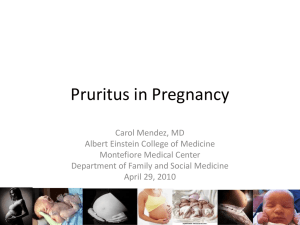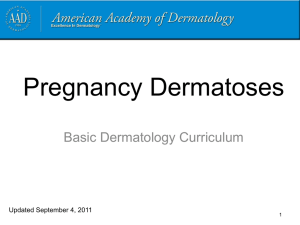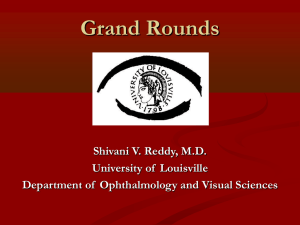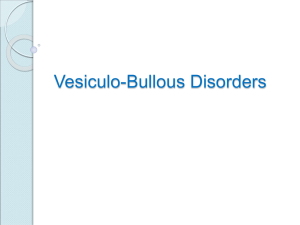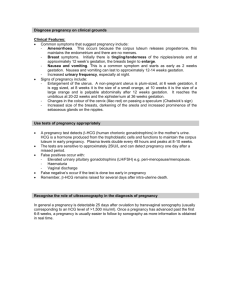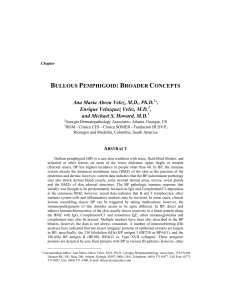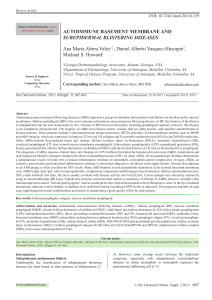GOGS Shin Ying Lee
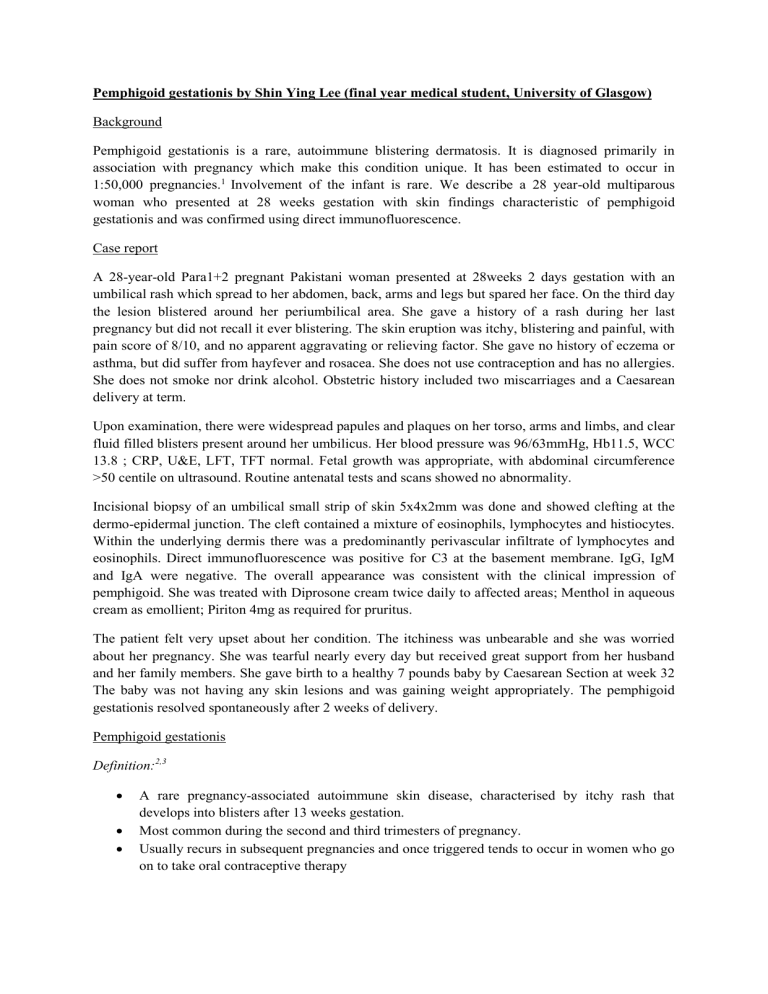
Pemphigoid gestationis by Shin Ying Lee (final year medical student, University of Glasgow)
Background
Pemphigoid gestationis is a rare, autoimmune blistering dermatosis. It is diagnosed primarily in association with pregnancy which make this condition unique. It has been estimated to occur in
1:50,000 pregnancies.
1 Involvement of the infant is rare. We describe a 28 year-old multiparous woman who presented at 28 weeks gestation with skin findings characteristic of pemphigoid gestationis and was confirmed using direct immunofluorescence.
Case report
A 28-year-old Para1+2 pregnant Pakistani woman presented at 28weeks 2 days gestation with an umbilical rash which spread to her abdomen, back, arms and legs but spared her face. On the third day the lesion blistered around her periumbilical area. She gave a history of a rash during her last pregnancy but did not recall it ever blistering. The skin eruption was itchy, blistering and painful, with pain score of 8/10, and no apparent aggravating or relieving factor. She gave no history of eczema or asthma, but did suffer from hayfever and rosacea. She does not use contraception and has no allergies.
She does not smoke nor drink alcohol. Obstetric history included two miscarriages and a Caesarean delivery at term.
Upon examination, there were widespread papules and plaques on her torso, arms and limbs, and clear fluid filled blisters present around her umbilicus. Her blood pressure was 96/63mmHg, Hb11.5, WCC
13.8 ; CRP, U&E, LFT, TFT normal. Fetal growth was appropriate, with abdominal circumference
>50 centile on ultrasound. Routine antenatal tests and scans showed no abnormality.
Incisional biopsy of an umbilical small strip of skin 5x4x2mm was done and showed clefting at the dermo-epidermal junction. The cleft contained a mixture of eosinophils, lymphocytes and histiocytes.
Within the underlying dermis there was a predominantly perivascular infiltrate of lymphocytes and eosinophils. Direct immunofluorescence was positive for C3 at the basement membrane. IgG, IgM and IgA were negative. The overall appearance was consistent with the clinical impression of pemphigoid. She was treated with Diprosone cream twice daily to affected areas; Menthol in aqueous cream as emollient; Piriton 4mg as required for pruritus.
The patient felt very upset about her condition. The itchiness was unbearable and she was worried about her pregnancy. She was tearful nearly every day but received great support from her husband and her family members. She gave birth to a healthy 7 pounds baby by Caesarean Section at week 32
The baby was not having any skin lesions and was gaining weight appropriately. The pemphigoid gestationis resolved spontaneously after 2 weeks of delivery.
Pemphigoid gestationis
Definition:
2,3
A rare pregnancy-associated autoimmune skin disease, characterised by itchy rash that develops into blisters after 13 weeks gestation.
Most common during the second and third trimesters of pregnancy.
Usually recurs in subsequent pregnancies and once triggered tends to occur in women who go on to take oral contraceptive therapy
Epidemiology:
Jenkins et al 1999 described the largest cohort of 87 patients in the United Kingdom with a total of
278 pregnancies, of which 142 were complicated by pemphigoid gestationis.
Pathogenesis(theory):
Some placental tissue enters the mother’s blood stream and triggers her immune system. IgG autoantibodies (PG factor) cause the damage. The target protein, BPAS2 is within the hemidesmosome. Blistering is caused by inflammation and separation of the epidermis from the dermis.
4
Associations:
Autoimmune diseases (HLA-DR3 and DR-4 haplotypes)
Hashimoto thyroiditis
Graves disease
Pernicious anemia
Signs and symptoms:
Intensely itchy hive-like rash during 13-40 weeks gestation
Initial – itchy red bumps around the belly button
Rash spreads to other parts of the body including the trunk, back, buttock, and arms. Face, scalp, palms, soles and mucous membranes are usually not affected
After 2-4 weeks, large, tense fluid-filled blisters form
- Throughout pregnancy, symptoms may lessen or spontaneously resolve towards term, but 78-80% will experience flare-up around delivery.
- In most cases, symptoms resolve days after giving birth. Commencement of menstrual periods, use of oral contraceptives or further pregnancies may cause flare-ups.
Investigations:
Skin biopsy
Direct immunofluorescence staining of the biopsy
In 2004, Sitaru et al demonstrated that immunoblotting is for the detection of autoantibodies to BP180 antigen and enzyme-linked immunosorbent assay is to monitor autoantibody serum levels. 5
Treatment:
The goals are
1) to relieve pruritus
2) to suppress extensive blister formation
3) to treat secondary infections. 2
To minimize the risk for the mother and fetus, use the lowest effective dose of medication to suppress disease activity.
Topical corticosteroids are used in mild disease. Use of oral corticosteroids in extensive cases needs careful monitoring. Dose may need to increase at term to prevent flaring after delivery.
2
Oral antihistamines may relieve itching.
Reported steroid-sparing agents (adjuvant therapy) include azathioprine, dapsone, methotrexate, intravenous immunoglobulin, cyclosporine, pyridoxine, plasmapheresis, and minocycline/nicotinamide. 4
In most cases, pemphigoid gestationis resolves spontaneously within days of delivery. Hence, treatment can be tapered off and stopped.
There is no contraindication to breastfeeding.
Multidisciplinary team: joint care by obstetrician, dermatologist and paediatrician.
Differential Diagnosis:
4
Bullous Pemphigoid
Cicatricial Pemphigoid
Linear IgA Dermatosis
Pruritic Urticarial Papules and Plaques of Pregnancy
Acute Urticaria
Complications:
Steroids may increase risk of diabetes and hypertension.
If secondary infection develops, there may be scarring.
Baby- premature delivery, transient blistering on infant, clearance of maternal antibodies (3-4 months), so careful observation of baby’s size and growth is vital.
Prognosis:
Pemphigoid gestationis may recur in subsequent pregnancies and may be precipitated by menses and the use of oral contraceptives. Cutaneous involvement in infants is rare (5-10%) and abates with clearance of the maternal antibodies.
4
References:
1. Bedocs PM, Kumar V, Mahon MJ. Pemphigoid gestationis: a rare case and review. Arch Gynecol
Obstet. May 28 2008
2.Article on Pemphigoid gestationis from DermNet NZ. Available from http://dermnetnz.org/immune/pemphigoid-gestationis.html
3. Pemphigoid Gestationis British Association of Dermatology Available from http://www.bad.org.uk/site/852/Default.aspx
4.Anatoli Freiman, MD, FRCPC, DABD Pemphigoid Gestationis Available from: http://emedicine.medscape.com/article/1063499-overview#a0104
5. Sitaru C, Powell J, Messer G, Brocker EB, Wojnarowska F, Zillikens D. Immunoblotting and enzyme-linked immunosorbent assay for the diagnosis of pemphigoid gestationis. Obstet Gynecol.
Apr 2004;103(4):757-63.
